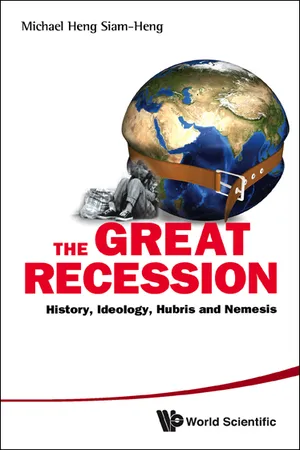Economics
Japan Lost Decades
The "Japan Lost Decades" refers to the period of economic stagnation that Japan experienced following the collapse of its asset price bubble in the early 1990s. This era was characterized by low economic growth, deflation, and a struggling banking sector. The government implemented various stimulus measures and monetary policies to try to revive the economy, but the effects were limited, leading to a prolonged period of economic malaise.
Written by Perlego with AI-assistance
Related key terms
5 Key excerpts on "Japan Lost Decades"
- 4Lost Decades and DisastersThe story of Japan’s Lost Decades began in the early 1990s, but the economic malaise persisted into the twenty-first century. Prime Minister Abe Shinzo promoted Abenomics to end that stagnation, and there are positive signs of progress in doing so, but after many false dawns over the years and the dilemmas posed by a shrinking and aging population, the public remains skeptical.The collapse of the late 1980s asset bubble precipitated the Lost Decades, as stock and land prices imploded by over 60 percent, burying banks under bad loans and forcing investors into staggering losses. The exuberance and hubris of the 1980s gave way to gathering anxieties that extended beyond the state of the economy. Two major events in 1995 – the Kobe earthquake and a terrorist attack by Aum Shinrikyo, a religious cult – reinforced public perceptions that the government was ineffectual, generating a sense of crisis and despair about a system that was no longer capable of dealing with the challenges confronting Japan. This vanishing confidence also drew on a series of scandals implicating the mandarins and politicians who were the guardians of the Japan, Inc., post-WWII model; they and that system lost credibility. These changing perceptions and ebbing support for a system that had worked quite well for four decades is propelling Japan’s slow-motion third transformation; it is so gradual and incremental there are reasons to doubt it is even happening. Yet, the ways and means of that model are now questioned. A frustrated public is no longer as deferential, and desperate for those in charge to offer a vision of hope and get on with the job.People understand that the bureaucrats who guided the economic miracle made a series of mistakes that led to the Lost Decades and also in dealing with the consequences. This was exacerbated by a fusty corporate culture, where complacency and inertia trumped a sense of urgency. People also better understand the limits of employer paternalism and to what extent a succession of political leaders have failed the test of leadership, perhaps with the exception of Prime Minister Koizumi Junichiro (2001–6) and the reincarnated Abe who disappointed in his first spell as prime minister in 2006–7, but has been more resolute since returning to power in 2012.
- eBook - ePub
Japan's Quiet Transformation
Social Change and Civil Society in 21st Century Japan
- Jeff Kingston(Author)
- 2004(Publication Date)
- Routledge(Publisher)
1 The Lost Decade ofthe 1990sThe so-called Lost Decade of the 1990s has been misunderstood because it really marks a watershed in Japan and has been a time of far reaching transformation. Gerald Curtis, Professor of Political Science, Columbia University, July 26, 2002During the Lost Decade the powerful and privileged lost while ordinary people benefited.Miyazaki Ikuko, founder of Mail Magazine , an internet job information service for working women, August 2002The final ten years of the twentieth century have been called a ‘lost decade’ for Japan, which continues to suffer woes from the burst of the late-1980s bubble economy. Japan's comeback as a globally competitive economic powerhouse will require fundamental reforms not only in the industrial and financial sectors but also in government administration, politics and social systems, including education, the judiciary and immigration.Japan Times , January 1, 2001The 1990s in Japan have been dubbed the Lost Decade. This is a period when the economy imploded, the asset bubble collapsed, banks teetered on the edge of insolvency, unemployment skyrocketed, suicides increased and the leaders of Japan, Inc. were tarnished by exposés of pervasive corruption. The nation of the ‘economic miracle’ found itself looking into the abyss, lunging from the swaggering late 1980s, when commentators gushed about a Pax Nipponica, to the sobering realities of the turn of the century when analysts predicted systemic collapse. The nation's credit rating slumped to the level of junk bonds and zombie companies staggered towards bankruptcy. Everything seemed to go wrong at the same time, an inauspicious beginning to the Heisei era, a period that has virtually become synonymous with Japan's prolonged recession.1What was lost in the Lost Decade? Mountains of money, a sense of security, stable families, and the credibility of the nation's leadership. To this standard list of debits one might add hubris and confidence about the future. The mighty have been brought low and the reputations of some have been dragged through the mud. Many topics that were once carefully avoided have now been brought into the open: subjects such as money politics, mob influence, and pervasive malfeasance are now regularly aired in a feistier national press. Also lost in the 1990s was an orchestrated innocence about the nation's shared past with Asia between 1931 and 1945. - eBook - ePub
Great Recession, The: History, Ideology, Hubris And Nemesis
History, Ideology, Hubris and Nemesis
- Michael Siam-Heng Heng(Author)
- 2010(Publication Date)
- WSPC(Publisher)
Chapter FourInsights from Japan’s “Lost Decade”a
Introduction
In retrospect, the most dramatic turning point in the half-century of Japan’s postwar economic development was the collapse of the property and stock market in 1990. The collapse ushered in a very long period of recession known as the “lost decade”.1 Japanese economy experienced average annual real growth of 0.8% from 1991 to 2001.2 One would expect that with fiscal stimuli, the economy would recover as in a normal business cycle. But somehow the recovery simply refused to show up. Conventional wisdom of economic stimulation does not tally with the Japanese experience of the long recession. The “lost decade” has acquired such an iconic status that economists and business columnists have evoked it as a possible prospect of the current recession for the USA.3Indeed, as the second largest economy in the world and operating in an electoral democratic framework, its experiences may shed some light on the nature of recession of an advanced industrial economy in the context of globalization, as well as the limitations of monetary and fiscal stimuli to deal with such a recession.There are three reasons for us to study Japan’s experiences for insights. First, America’s and the UK’s troubles are in some deep sense similar to Japan’s. They are a result of a real estate bubble and easy credit. The prices of resident property in 10 largest cities of the USA doubled in five years, just like those prices in Japan’s big cities during the bubble period.4 What is more disturbing is that nationwide, prices of resident units, and commercial property in the US and the UK shot up more than they did in Japan. It is also relevant for Asia because a property bubble preceded the 1997 crisis. Second, Japan shares the essential features of an advanced industrial economy with Western Europe and the USA. The “lost decade” is likely to hold lessons for them. Third, the Japanese trajectory of economic development has offered very useful concepts for other Asian countries to emulate. This pattern is captured metaphorically in the “Flying Geese” model.5 - eBook - ePub
Financial Crisis, Contagion, and Containment
From Asia to Argentina
- Padma Desai(Author)
- 2014(Publication Date)
- Princeton University Press(Publisher)
4 Japan: The Lost Decade of the Nineties amidst Policy Paralysis T HE J APANESE ECONOMY’S prolonged decline in the nineties turned into a recession toward the end of 2000 marked by mounting price deflation. During this period, attempts to revive the economy via fiscal pump priming led to resource misuse into pork barrel projects. Monetary easing failed to stimulate consumer demand by households or capital spending by industry. A softening of the yen in late 2001 calculated to boost exports raised protests from Asian neighbors and the U.S. treasury. The prolonged policy paralysis, which I analyze in this chapter, arose from the leadership’s failure to enforce a cleanup of banks that were burdened by massive nonperforming loans and free Japanese industry from widespread regulations and high taxes. The economy’s decline also affected Japan’s traditional role as an active investor and lender in the small Asian economies and affected their export sectors as the Japanese recession coincided with that of the U.S. after 9/11. The Mounting Economic Malaise In the late eighties, propelled by expansionary fiscal and easy monetary stimuli, Japan turned into a bubble economy of unparalleled asset price inflation especially in urban land values that rose sevenfold in less than a decade, in turn providing collateral against bank lending to companies that dizzily invested in real estate and urban property. The keiretsu, “happy-family” links between banks and industry groups marked by cross-shareholdings and low-margin corporate lending by banks, misallocated capital in dubious projects financed by bank loans to the tune of 12 percent of gross domestic product (GDP) when asset prices collapsed from their 1990 peak. Property prices continued tumbling for the ninth year in a row in 1999 forcing sales of some urban commercial properties at 80 percent or more below their peak values - eBook - ePub
- Manas Chatterji, Partha Gangopadhyay(Authors)
- 2017(Publication Date)
- Routledge(Publisher)
Chapter 15 Japan: Maturity and Stagnation? Bill Lucarelli and Joseph Halevi IntroductionJapan has now been mired in economic stagnation and recession for the past decade. What are the causes of this malaise? Is it merely the natural consequence of financial retrenchment after the collapse of the ‘bubble’ economy in the early 1990s, or does the present slump signify a more profound historical phase of industrial maturity and decline? The aim of this study is to provide several tentative hypotheses. In the first section, the onset of crisis and stagnation in Japan after the collapse of the ‘bubble economy’ in the early 1990s will be examined. The second section provides a more detailed exposition of Japan’s oligopolistic role in the East Asian region from a Baran-Sweezy-Magdoff perspective.The Era of EndakaThe result of the US pursuing an exchange-rate approach to the problem of trade with Japan was profound. They made no difference to the trade imbalance, but they stimulated Japan to undertake countermeasures to the high yen, which led to Japan’s bubble economy, then to the collapse of the bubble economy, then to Japan’s export of its bubble economy to South East Asia, and finally to the economic meltdown that confronts us today (Johnson, 1998, p.656).Japan’s current economic malaise has its roots in the chain of events that led to the expansionary monetary policies enacted after the September 1985 Plaza accords. The sharp appreciation of the Japanese yen failed to restore a balance of payments equilibrium with the US. The period of endaka, or the skyrocketing increase in the value of the yen, soon began to undermine the profitability of Japan’s exports. By shifting a substantial proportion of their labor-intensive manufacturing offshore to the cheap labor zones of South East Asia, Japanese transnational corporations were able to restore their export competitiveness (Kriesler and Halevi, 1996). In order to mitigate the effects of an appreciating yen, the Japanese government embarked upon a program of monetary accommodation by reducing interest rates. Yet by pursuing relatively loose monetary policies, the government set in motion an unprecedented expansion of excess liquidity in the capital markets, most of which was channeled into what became known as zaitech operations, or speculative financial engineering (Yoshikawa, 2001). In retrospect, a financial mania was triggered in the real estate and equity markets.1
Learn about this page
Index pages curate the most relevant extracts from our library of academic textbooks. They’ve been created using an in-house natural language model (NLM), each adding context and meaning to key research topics.




